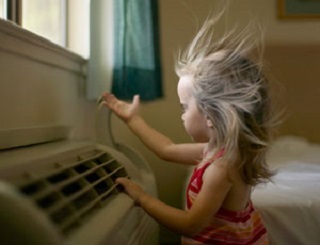From Guest Blogger Lizzie Weakly: Environmental HVAC–How to Go Green with Your Home Heating and Cooling

Go Efficient
Older HVAC units are not as efficient as newer ones. Replacing an ancient system has the potential to significantly reduce the amount of energy you use.
Even among new systems, there’s a wide range of efficiency levels. The higher the Seasonal Energy Efficiency Rating (SEER), the more efficient the system.
If your old system breaks, that’s a good motivator to install an updated one. However, even if your old unit is still plugging away, it can be a smart idea to make the switch now. You’ll probably notice that your heating and cooling bills will go down; plus, you’ll lower your risk of the old system finally giving out in the middle of a particularly hot or cold day.
Go Solar
Sunlight is a renewable resource, and if you channel it properly, you can use it as an HVAC source for your home. A solar heating or cooling system collects energy from the rays of the sun and converts it into useable electricity to keep the furnace or central air running at a comfortable temperature.
When your HVAC system is powered by the sun’s rays, you will reduce your household dependency on natural gas. According to Custom Comfort, “Solar based systems are a great alternative to gas fired equipment.”
In fact, in addition using solar energy to keep your house at a comfortable temperature, you can also use it to power a water heater.
Go Geothermal
Like solar power, geothermal power is another way to reduce your reliance on natural gas. But whereas solar energy comes from above, geothermal heating and cooling are sourced from below.
Underground, the temperature remains a fairly consistent 50-something degrees year-round. Pipes buried in the ground carry a fluid that is used for heat transfer, and because the underground temperature remains comfortably steady, the temperature of the liquid does too.
Because a geothermal system always draws on the mid-temperature fluid in its pipes for heat exchange, the process requires significantly less energy than a conventional system does. The results are a greener approach to HVAC and lower power bills for you.
A green HVAC system is good for the environment. Over time, it’s also good for your wallet because you can recoup your upfront costs through lower energy bills.

From the article:
“Sunlight is a renewable resource, and if you channel it properly, you can use it as an HVAC source for your home. A solar heating or cooling system collects energy from the rays of the sun and converts it into useable electricity to keep the furnace or central air running at a comfortable temperature.”
Actually, there is another way to do it which may be more efficient and which is not mentioned by the article, i.e., an absorption system.
The absorption system for cooling uses very little electricity. Instead, it directly uses heat to do the work. There are two basic systems:
1. The ammonia / water system, and
2. The lithium bromide / water system
The lithium bromide / water system has for many decades used waste heat for its operation and is commonly used to cool large buildings. However some systems use atmospheric steam as the heat source. The ammonia / water system generally runs on heat produced by burning gas although it can use any heat source which is at a high enough temperature; it requires a higher temperature than the lithium bromide / water system.
The COP* (coefficient of performance) for absorption systems is generally less than unity which seems inefficient. Vapor compression air conditioning generally has a COP > 3. However, the efficiency of PV panels generally does not exceed 16% which means that an absorption system using the lithium bromide / water cycle would most likely require less area for the solar collectors than an electric air conditioning system that gets its power from PV panels.
Absorption system do require some electricity for operating pumps to circulate liquids, but that power is minimal.
A Japanese company has done some work on solar powered absorption air conditioning systems but I do not know that the current state of the technology is.
* Note that EER can easily be converted to COP. EER is a hybrid ratio computed by dividing BTUs out by watts in. COP uses the same units for both output and input and therefore provides a better intuitive feel for the actual efficiency. It also makes more sense internationally because countries which are fully metricated do not use BTU so when COP is calculated, it will be the same in all countries. Unfortunately we seem to be stuck with EER, at least temporarily.
For more information, try a google search on “solar absorption air conditioning” or something similar.